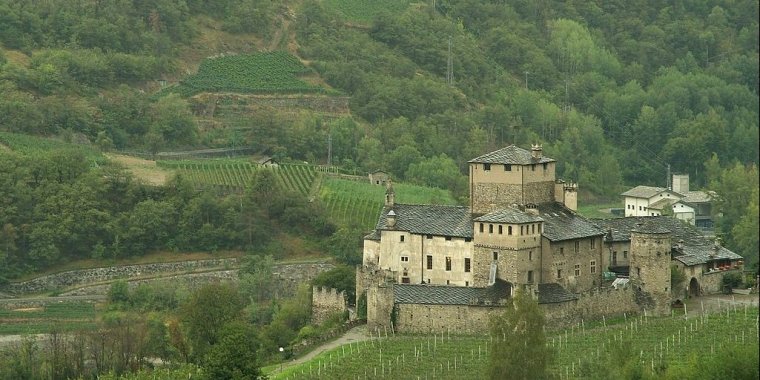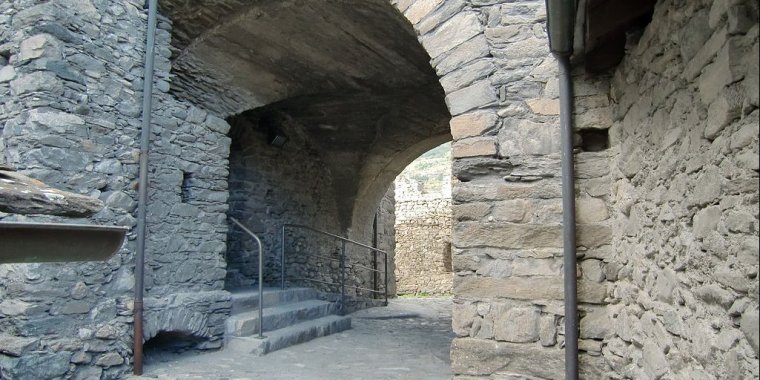| Travel / Tourist Attractions |
Sarriod de la Tour Castle, Saint-Pierre, Italy

Sarriod de la Tour Castle, Saint-Pierre, Italy. ![]()
Sarriod de la Tour Castle is a castle in the town of Saint-Pierre by the Dora Baltea River, in Northwestern Italy's Aosta Valley. The original castle was typical of the style built between the 10th and 12th centuries, and was greatly expanded by Jean Sarriod in 1420 and his son, Antoine, in 1478. The north wing's ground floor features a wooden-ceilinged "Hall of Heads", named for its decorative motifs.
The Sarriod de la Tour Castle was the family residence of the Sarriod family since its founding. The Sarriods were politically linked to the powerful Bard family in the County of Savoy.
The oldest part of the castle included a chapel and square tower, or donjon, surrounded by the castle walls, typical of the Aosta Valley 10th- to 12th-century castles. In 1420 Jean Sarriod expanded upon the "turris Sariodorum", as the donjon was known.
The "Hall of Heads", built in 1430, features 171 corbels of grotesques of mythological monsters and animals bearing coats of arms. In 1478 Jean's son, Antoine Sarriod de la Tour, refurbished the chapel dedicated to the Virgin Mary and Saint John the Evangelist, by having painted the external frescoes of the Crucifix and Saint Christopher and caused to be built the small bell tower.
The castle wall's circular and semi-circular towers were added sometime in the late 15th century, when a new entrance was created on the eastern side. In the 16th century a west-facing wing was added, then, in the 17th century, a north tower.
The Sarriod family inhabited the castle until 1923. In that year the castle went to the Genoese Bensa family. Since 1970, it has been property of the autonomous Region Aosta Valley.

Sarriod de la Tour Castle, Entrance to the courtyard. ![]()
The castle is visible from the National Road No. 26 which runs from Ivrea to the Little St Bernard Pass. Sarriod de la Tour is open to visitors year round.
Tourist Info
Opening:
Accompanied visit: last tour 30 minutes before closing time.
• April to September: 9 a.m. – 7 p.m. daily
• October to March: open Tuesdays to Sundays 10 a.m. – 1 p.m. / 2 – 5 p.m.
Closed from 2nd to 9th March 2020
Admission:
• Full price ticket: 3.00 euro
• Reduced entrance-fee: 2.00 euro (groups of at least 25 paying visitors, university students, specific deals)
• Under 18s reduced entrance-fee: 1.00 euro (visitors aged 6 – 18, school groups)
• Free:
— children under 6
— visitors with disabilities and their companions
— teachers and other persons accompanying school groups, 1 person per 10 students.
Rules for visitors
• Access: entry allowed for groups up to 25 people per visit.
• Tickets: advance sale from opening time onwards, following the arrival order, until last visit.
• People with disabilities: partially accessible.
• Photos and videos: it is possible to take pictures and videos, for private use and not for gain, with any device without flash and support. Shooting with selfie stick is forbidden. Using shots and films for advertising, press or commercial purposes is allowed only upon authorization.
• Pets: small animals are admitted inside the monument only if held in one’s arms or transported in a pet carrier.
Sources
• www.wikipedia.org
• www.lovevda.it
YOU MAY ALSO LIKE





